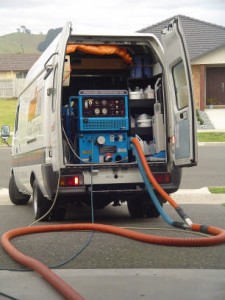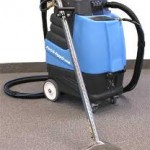What does carpet cleaning remove?
Ok, most of the contaminants in the carpets are dry loose particles – generally, up to 80% of carpet soiling is dry particulate (or sandy type stuff), and the most effective way to remove this type of soiling is via a thorough slow vacuuming. What is left behind is the ‘oily’ type soil that is attached to the carpet fibres, much like oily hair – the only way to remove this is with an effective cleaning system – it won’t just ‘suck’ out. Other contaminants may have attached more securely to the fibre, or even have changed the property of the fibre. This is known as staining, and will require special treatment to reduce, or hopefully remove.
What is the best carpet cleaning method for residential carpets?
The best method by far is the Hot Water Extraction method. This method is often called “Hot Water Extraction” or “Steam Cleaning” and is the cleaning method nearly all carpet manufacturers and carpet fibre producers recommend.
This is the only cleaning method classified as “deep cleaning”. Other types of cleaning are considered “Maintenance Methods” because they struggle to remove soil from deep in the pile. Most other methods generally leave amounts of cleaning agent in the carpet after cleaning.
The maintenance brochure published by the world’s largest carpet manufacturer, Shaw Industries, recommends this method, because its own research indicates that it provides the best capability for cleaning.
Let’s take a closer look at the different types of carpet cleaning methods:
1. Hot Water Extraction (van mounted machinery)
Benefits:
a) TRUE deep cleaning process – cleans to the base of the fibres when performed properly. Results are often spectacular when used in conjunction with some type of scrubbing process.
b) Very powerful process, with huge airflow – allows the operator to use lots of water to flush the carpet without overwetting.
c) More flushing = better results and less residue left behind.
d) Able to reach high temperatures – great for cutting through soil.
e) No need to empty dirty water into toilets or sinks – systems are self contained.
Challenges:
a) Not really suitable for high rise situations over three storeys high.
b) Can be quite noisy in the driveway (although very quiet inside the home).
Very similar process to that of an average portable hot water extraction machine, but with larger and more powerful capabilities.
Van or truck mounted extraction machines are capable of flushing and extracting much more effectively than most portable machines. They also have the added advantage of higher levels of heat, which adds even further to the ability to remove those oily soils. At the lower end of the van mounted equipment scale are the smaller air cooled engine machines, up to the full scale power of a 4 cylinder, very high air flow unit.
While these van mounted machines operate at high pressure, flushing more water through the carpet than a portable machine, they have the higher air flow capability to remove the water.
If used properly, carpets cleaned with these mega flushing machines are cleaned all the way down to the base of the fibre, WITHOUT wetting the backing and underlay. They generally leave the carpet damp to touch, and should dry in a reasonable amount of time under normal conditions.
2. Hot Water Extraction (portable machinery)
Benefits:
a) Good process for removing dirt from reasonably deep in the fibre.
b) Excellent results able to be achieved when used in conjunction with any type of scrubbing process.
c) Powerful portable extractors (with multiple vacuum motors) can be as powerful as a small van mounted machine.
Challenges:
a) Vacuum capability is often very low, meaning the operator can’t use lots of water to flush well, resulting in residue being left behind.
b) If too much water is used, the carpet can become wet all the way through to the underlay, causing major problems.
c) Difficult to perform a deeper clean with a lower powered unit (for the reasons above).
d) Can be quite noisy inside.
Many operators use the hot water extraction method via an electric portable extraction machine that comes into the house and plugs into the mains power.
As with any method, a thorough vacuum should be performed to remove as much of the dry embedded soil as possible. A detergent is then applied to the carpet via a sprayer or scrubbing machine. Some portable hot water extraction machines have a means of agitating the carpet, which is great for dirty high traffic areas, and then extract by flushing water through the carpet and sucking it out instantaneously, along with the dirt.
Some operators manage to perform a pretty good clean with this equipment. The down side is that the units are normally very low pressure, and don’t have the ability to flush the carpets very well. These machines are designed with low water pressure for a reason: the vacuum motors (or motor) aren’t overly powerful due to the limitations of the power circuitry in most homes. Therefore, manufacturers need to control the amount of moisture going in, because they know the ability to retrieve it is limited. If the carpet is quite soiled, there is a high likelihood that an operator will use as much water as he can to flush the carpet, resulting in a carpet that may contain enough moisture to soak the carpet backing, and even the underlay.
3. Dry Foam Cleaning
Benefits:
a) Can be performed more quickly than hot water extraction.
b) Normally dries more quickly than hot water extraction as only the top part of the fibre is wet during the process.
c) Very viable option for lightly soiled high rise apartments, and commercial areas that need to be opened up soon after cleaning.
Challenges:
a) Definitely not a deep cleaning method – deals mainly with the top of the carpet fibre.
b) Inability to flush away major contaminants such as vomit or faeces, or deep food spills.
c) Dirt can remain in the carpet after cleaning until being vacuumed out later.
d) Limited success on heavily soiled carpets.
“DRY FOAM” covers a range of methods which involve the application of a foam or detergent to the carpet with a scrubbing machine. A good thorough and deep pre-vacuum with a good brush powered vacuum is ESSENTIAL to the success of these methods.
The vacuuming removes almost all of the dry soil particles, leaving the “oily” type soils attached to the carpet fibres.
The foam is then scrubbed onto the carpet and either left to dry, retrieved with a vacuum machine or “buffed” off with cotton pads that are rinsed out as they become dirty.
Most chemicals available these days for this type of cleaning are known as ‘encapsulating detergents’, and when they dry they encapsulate the dirt particles within tiny microscopic crystals, and are vacuumed out during subsequent vacuuming by the home or business owner, leaving little or no harmful residue.
Dry Foam methods are known as a ‘maintenance’ method because they deal more with the “look” of the surface of the carpet, rather than providing a deep cleaning of the carpet. The Dry Foam method for cleaning carpets could be likened to washing your hair with a shampoo, then leaving it to dry and shaking out the left over dirt later, rather than rinsing it out after shampooing.
Be aware that some Dry Cleaning systems offer to “Brighten” your carpet. These systems may contain high levels of optical brighteners which take invisible ultraviolet light and convert it to visible light, thus making the carpet appear cleaner and brighter than it really is, for a while. It will eventually give the carpet a dull or yellow hue, which cannot be removed.
Dry foam/encapsulation methods are ideal for synthetic commercial glued down carpets, and sometimes low to medium soiled residential carpets, and are often recommended in ‘consumer reports’ as the best method (normally from USA sources where 99% of carpets are synthetic, not wool). Often they are a good solution for areas that need to be cleaned quickly and be available for use in a hurry – because usually these processes leave carpets dry within a couple of hours of less.
This process is not ideal for heavily soiled residential carpets, especially where food spills, vomit, blood or embedded detergents are an issue (these types of spill need to be flushed out properly with water).
So, is it all about equipment?
No, definitely not! As with any industry, you’ll find operators who have the absolute best equipment money can buy, but have no real idea of how to use it to its best advantage – just as you’ll find operators who get by with very limited equipment, but have a great reputation for getting the job done right, although if the company you use to clean your carpets has invested well in equipment and systems, then it stands to reason that you’re more likely to get a good result.


